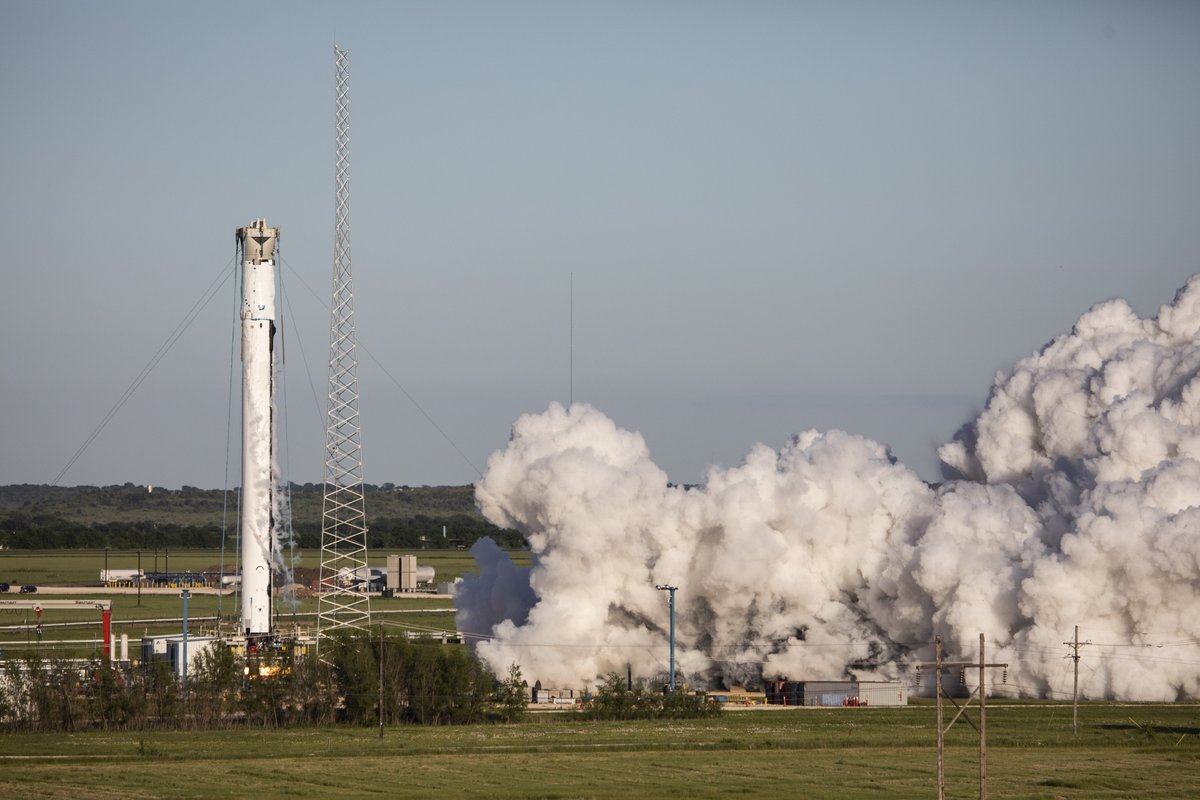SpaceX Test Fires Falcon Heavy Megarocket Core for June Mission (Photo)

Just two weeks after SpaceX's Falcon Heavy rocket aced its first commercial mission, the company is gearing up for another flight of the powerful launcher.
SpaceX performed a static fire test with a Heavy core stage at its Texas facility recently, to lay the groundwork for a June launch that will send 23 satellites to orbit.
"Falcon Heavy center core booster completed a static fire test at our rocket development facility in McGregor, Texas ahead of its next mission → http://spacex.com/stp-2," SpaceX representatives wrote via Twitter on Friday (April 26).
Related: SpaceX's Falcon Heavy: Latest News, Images and Video
The Falcon Heavy combines three modified first stages of SpaceX's workhorse Falcon 9 rocket. A single-engine second stage, and the payload, top the central booster.
The three first stages are reusable, and they're designed to come back to Earth for pinpoint landings shortly after launch. During the Heavy's previous mission, an April 11 launch that lofted the Arabsat-6A communications satellite, all three boosters aced their touchdowns — the two side boosters on terra firma and the central core on a ship at sea. (The core didn't make it safely back to shore, however; rough seas caused it to topple.)
The upcoming mission, the first Heavy flight for the United States Department of Defense, is called Space Test Program-2 (STP-2). It's scheduled to launch on June 22 from historic Pad 39A at NASA's Kennedy Space Center in Florida, according to Spaceflight Now.
Breaking space news, the latest updates on rocket launches, skywatching events and more!
If all goes according to plan, the rocket will deliver nearly two dozen spacecraft to a variety of orbits.
"The STP-2 mission will be among the most challenging launches in SpaceX history with four separate upper-stage engine burns, three separate deployment orbits, a final propulsive passivation maneuver and a total mission duration of over six hours," SpaceX representatives wrote in a mission description.
"In addition, the U.S. Air Force plans to reuse side boosters from the Arabsat-6A Falcon Heavy launch, recovered after a return to launch site landing, making it the first reused Falcon Heavy ever flown," they added.
The 23 satellites going up on June 22 are a diverse lot that will be operated by a variety of customers, not just military organizations.
For example, NASA's Green Propellant Infusion Mission will test a new type of fuel that could improve the safety and efficiency of spacecraft propulsion. And a craft called Prox-1, which was built by students at the Georgia Institute of Technology, will demonstrate the ability of small satellites to perform close-encounter operations, according the SpaceX mission description site.
Prox-1 will also deploy LightSail 2, a tiny cubesat built by the nonprofit Planetary Society to help advance solar-sailing technology.
STP-2 will be the third Falcon Heavy mission overall. The rocket first took flight in February 2018, on a demonstration mission that sent SpaceX founder and CEO Elon Musk's red Tesla Roadster into orbit around the sun.
- Arabsat-6A in Photos: SpaceX's Amazing Falcon Heavy Triple Rocket Landing
- In Photos: SpaceX's 1st Falcon Heavy Rocket Test Launch Success!
- The Evolution of SpaceX's Rockets in Pictures
Mike Wall's book about the search for alien life, "Out There" (Grand Central Publishing, 2018; illustrated by Karl Tate), is out now. Follow him on Twitter @michaeldwall. Follow us on Twitter @Spacedotcom or Facebook.

Michael Wall is a Senior Space Writer with Space.com and joined the team in 2010. He primarily covers exoplanets, spaceflight and military space, but has been known to dabble in the space art beat. His book about the search for alien life, "Out There," was published on Nov. 13, 2018. Before becoming a science writer, Michael worked as a herpetologist and wildlife biologist. He has a Ph.D. in evolutionary biology from the University of Sydney, Australia, a bachelor's degree from the University of Arizona, and a graduate certificate in science writing from the University of California, Santa Cruz. To find out what his latest project is, you can follow Michael on Twitter.
